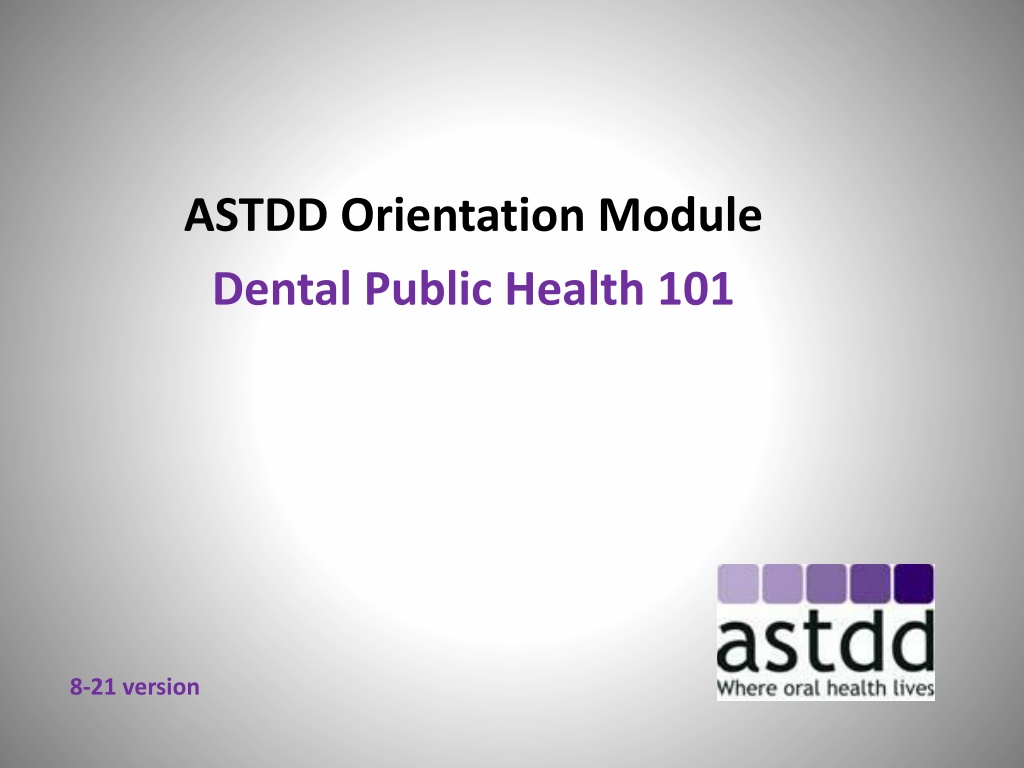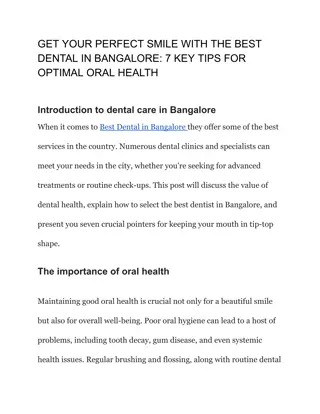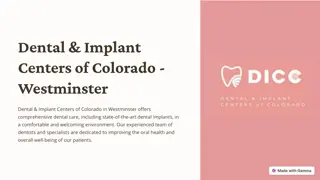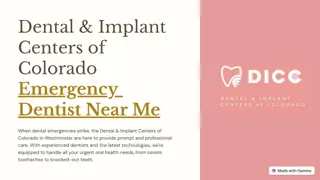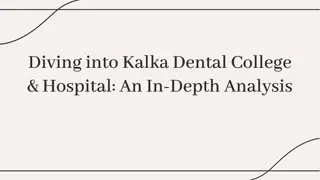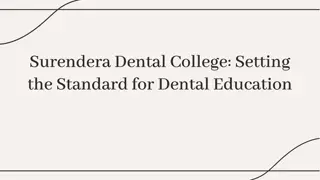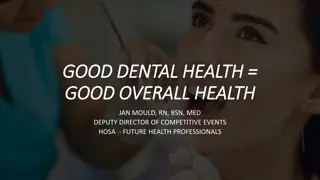Overview of Dental Public Health
Dental Public Health (DPH) focuses on community oral health, disease prevention, and health promotion through organized efforts. This specialty area within dentistry addresses population-based care, policy development, and maintaining the dental safety net. DPH professionals work to improve oral health at a community level, facing challenges related to defining roles and qualifications in this field.
Download Presentation

Please find below an Image/Link to download the presentation.
The content on the website is provided AS IS for your information and personal use only. It may not be sold, licensed, or shared on other websites without obtaining consent from the author.If you encounter any issues during the download, it is possible that the publisher has removed the file from their server.
You are allowed to download the files provided on this website for personal or commercial use, subject to the condition that they are used lawfully. All files are the property of their respective owners.
The content on the website is provided AS IS for your information and personal use only. It may not be sold, licensed, or shared on other websites without obtaining consent from the author.
E N D
Presentation Transcript
ASTDD Orientation Module Dental Public Health 101 8-21 version
Acknowledgments This module was supported by Cooperative Agreement 5U58DP004919-03 and 5 NU58DP006573-02-00 and 03- 00 from the Centers for Disease Control and Prevention (CDC), Division of Oral Health (DOH). Its contents are solely the responsibility of the authors and do not necessarily represent the official views of CDC. Thanks to the American Dental Association (ADA) Council on Access, Prevention, and Interprofessional Collaboration (CAPIR) for permission to adapt material from their Dental Public Health (DPH) Module.
Dental Public Health (DPH) 101 Learning Objectives Define Dental Public Health and compare DPH practice to clinical dental practice, noting any areas of overlap or controversy. Describe the various components and work sites of the DPH infrastructure and how they relate to each other. Compare the missions, members and activities of various national organizations.
Dental Public Health (DPH) 101 Learning Objectives (cont) List the three core public health functions and the 10 essential public health services to promote oral health. Define selected key public health concepts and the national prevention agenda. List some key dental public health/oral health accomplishments. Discuss some key DPH challenges.
What is Dental Public Health? One of 10 American Dental Association recognized specialties, established in 1950 Focuses on dental and oral health issues in communities and populations vs. individuals Described as: The science and the art of preventing and controlling disease and promoting dental health through organized community efforts
What is Dental Public Health? (cont) Dental Public Health is that part of dentistry providing leadership and expertise in population-based dentistry, oral health surveillance, policy development, community- based disease prevention & health promotion, and the maintenance of the dental safety net.
What is Dental Public Health? (cont) Who is a dental public health professional a dentist who has successfully completed a DPH residency and passed the specialty boards, a dental professional (dentist or dental hygienist) who has graduated with an MPH degree with or without a concentration in DPH, or any dental professional working in a public health clinical setting? There still is no clear consensus, which creates numerous challenges.
Clinical Dental Practice & Public Health Dentistry Complementary roles Shared objectives optimal oral health Every dental professional can be viewed as part of the DPH infrastructure, but all dental professionals are not dental public health professionals.
Clinician and DPH Practitioner Comparison Dental Clinician Focuses on the individual patient DPH Practitioner Focuses on the community, which could be defined by geographic or political boundaries, socio- demographic characteristics, or health status Implements OH surveillance systems and collects data on community oral health status Conducts patient examinations
Clinician and DPH Practitioner Comparison Dental Clinician Establishes patient diagnosis DPH Practitioner Analyzes and interprets data from surveillance systems, surveys and other data sources Engages community partners and forms community OH coalitions; develops a community OH plan to address the findings from OH surveillance; plans community-based prevention and treatment programs; develops policies to address needs Discusses findings with patient and develops treatment plan
Clinician and DPH Practitioner Comparison Dental Clinician Provides treatment to patient DPH Practitioner Implements evidence-based, community-based oral health programs, which requires gathering resources in an organized and rational way and preferably with broad-based community support and involvement Obtains funding to operate programs, which may come from a range of sources including government, private foundations, philanthropic organizations, and commercial or private donors Conducts program evaluations Receives payment for services Schedules periodic follow-up patient visits
The DPH Infrastructure A broad-based, informal, and diverse network of public and private organizations, as well as individuals, committed to improving oral health through organized community-focused policies and programs Monitors the oral health status of communities Oversees community-based oral disease prevention programs
The DPH Infrastructure (cont) Establishes policies to maintain and improve oral health and access to care Involved in research in population health, epidemiology, and disease prevention and control Assures the safety and effectiveness of the oral health care system for those providing and obtaining oral health care.
Examples of Public Health Worksites City, county, tribal, state and territorial health departments Federal government agencies: Indian Health Service (IHS), Veteran s Administration (VA), Department of Defense (DOD), Centers for Disease Control and Prevention (CDC), National Institutes of Health (NIH), Health Resources and Services Administration (HRSA), Centers for Medicare and Medicaid Services (CMS), Administration for Children and Families (ACF), Bureau of Prisons (BOP), and the Food and Drug Administration (FDA).
Examples of Public Health Worksites (cont) Academia: Health professions schools, schools of public health, public policy institutes, and research centers Community-based settings: Correctional facilities, long-term care facilities, school-based health programs, mobile and teledentistry programs Clinics: Federally Qualified Health Centers (FQHCs), which include migrant, homeless, public housing and Native Hawaiian sites; tribal clinics; and non-profit and/or volunteer clinics.
Components of the DPH Infrastructure Government: State and local health departments, federal agencies (see The Role of Health & Human Services and Its Agencies in Promoting Oral Health) Organizations: national (See the ASTDD slideshow on national organizations), state, local, public, private, foundations, and many others Education: Dental and Dental Hygiene Schools & Graduate/Residency Programs; Schools of Medicine, Nursing, and Allied Health Sciences; Schools of Public Health; Preschool, Primary and Secondary Schools Workforce: Oral Health Professionals, Physicians, Physician Assistants, Nurse Practitioners, Nurses, Pharmacists, Midwives, Community Health Workers/Promotoras, Community Dental Health Coordinators, Water Plant Operators, Teachers, School Administrators, Parents, Caregivers and others.
Key Organizations: Association of State and Territorial Dental Directors Mission: ASTDD provides leadership to: promote and support a governmental oral health presence in each state and territory, increase awareness of oral health as an important and integral part of overall health, address oral health equity, promote evidence-based oral health policies and practices, and assist in the development of initiatives to prevent and control oral diseases. Members: Primary voting members are the directors of state/territorial public health agency programs for oral health; other interested individuals or groups are associate members; ASTDD is one of 21 affiliates of the Association of State and Territorial Health Officials (ASTHO). Activities: Co-sponsors the National Oral Health Conference; conducts a peer support program; collects data for annual State Synopses and the National Oral Health Surveillance System; technical assistance and training; provides reports, news updates, guidelines, state oral health program competences, best practice approach reports and other DPH resources.
Key Organizations: American Association of Public Health Dentistry Mission: To provide leadership in ensuring optimal oral health for individuals and communities. Membership: All individuals concerned with improving the oral health of the public; there are several membership categories. Activities: Sponsors the American Board of Dental Public Health; publishes the Journal of Public Health Dentistry and a newsletter; co-sponsors the National Oral Health Conference; supports student chapters; maintains a speakers bureau for curriculum modules; provides information about accredited DPH residency programs; produces white papers and policy statements; the charitable Foundation arm sponsors scholarships and small grants.
Key Organizations: American Board of Dental Public Health Serves as the national examining and certifying body for the DPH specialty. Creates DPH standards of practice and writes DPH Competencies with AAPHD. Grants and issues DPH certificates to those who pass the specialty boards. Ensures continuing competency of diplomates.
Key Organizations: American Association for Community Dental Programs Purpose: AACDP supports the efforts of those serving the oral health needs of vulnerable populations at the community level. Members: AACDP is a voluntary membership organization. Members include staff of city, county, and community-based health programs with an interest in oral health issues and access to care. Activities: Member benefits include an annual meeting and subscription to the Community Oral Health Programs (COHP) discussion list.
Key Organizations: Medicaid/Medicare/CHIP Services Dental Association Mission: To improve Medicaid, Medicare, and CHIP oral health programs by collaborating with key stakeholders, sharing resources, and disseminating innovative strategies Membership: State Medicaid and CHIP oral health program directors and staff, Medicaid providers, public and private health insurers, educators, policy makers, and others Activities: Provide leadership in developing sound Medicaid, Medicare, and CHIP oral health/dental policy; provide a support system to state and national Medicaid/CHIP dental program representatives; encourage innovation and collaboration among state and national Medicaid/CHIP dental program representatives; promote the integration of oral health and primary care in Medicaid/CHIP programs; promote an appropriate balance between the prevention and treatment of oral diseases and conditions.
Key Organizations: National Network for Oral Health Access Mission: To improve the oral health of underserved populations and contribute to overall health through leadership, advocacy, and support to oral health providers in safety-net systems. Members: NNOHA is a membership organization of safety-net oral health practitioners, programs and supporters. Activities: NNOHA provides resources and learning opportunities ranging from the Operations Manual that outlines the best approaches to running an efficient and effective practice, to the Annual Conference which provides both training and networking opportunities for participants.
Key Organizations: American Public Health Association, Oral Health Section Mission/goals: Promote the importance of oral health; increase access to oral health preventive and treatment services; monitor and disseminate information about the oral health needs of the public Members: Health professionals who join APHA and indicate their interest in the oral health section Activities: Promote oral health to a full multidisciplinary audience including during the annual APHA conference; partner with other human service providers; integrate oral health with overall health; have input into environmental and health care delivery issues; disseminate research findings to the broadest possible audience; provide professional and student awards.
Why is DPH Important to State and Territorial Health Departments? State and territorial oral health programs report oral disease rates and improvements in the state s population, develop and implement policies and programs to prevent or minimize diseases, and assure that laws and regulations are in place to keep the public safe and healthy. In 2000 the U.S. Surgeon General reported that the public health infrastructure for oral health is insufficient to address the needs of disadvantaged groups and integration of oral health and general health programs is lacking. ASTDD promotes a strong and effective governmental oral health presence in states and territories to assure optimal oral health for all Americans. These are some reasons why state oral health programs are important.
Public Health Core Functions Assessment Regular collection and dissemination of data on health status and community health needs utilizing epidemiologic principles and surveillance systems Policy Development Use of scientific knowledge and data in decision making affecting the public s health and to establish goals Assurance Implementing the appropriate programs to achieve the desired goals.
10 Essential Public Health Services to Promote Oral Health in the U.S. Assessment 1. Assess and monitor the population s oral health status, factors that influence oral health, and community needs and assets. 2. Investigate, diagnose and address oral health problems and hazards affecting the population.
10 Essential Public Health Services to Promote Oral Health in the U.S. (cont) Policy Development 3. Communicate effectively to inform and educate people about oral health and influencing factors and educate/empower them to achieve and maintain optimal oral health. 4.Mobilize community partners to leverage resources and advocate for/act on oral health issues. 5. Develop, champion and implement policies, laws and systematic plans that support state and community oral health efforts. 6. Review, educate about and enforce laws and regulations that promote oral health and ensure safe oral health practices.
10 Essential Public Health Services to Promote Oral Health in the U.S. (cont) Assurance 7. Reduce barriers to care and assure to and use of personal and population-based oral health services. 8. Assure an adequate, culturally competent and skilled public and private oral health workforce. 9. Improve and innovate dental public health functions through ongoing evaluation, research and continuous quality improvement. 10. Build and maintain a strong organizational infrastructure for dental public health.
Key Public Health/DPH Concepts Social determinants of health/oral health: The conditions in which people are born, grow, work, live, and age, and the wider set of forces and systems shaping the conditions of daily life Common risk factor approach: A method used to create cross-disciplinary health promotion programs sharing common risk factors for disease as many of the behavioral risk factors negatively impacting oral health also have a detrimental effect on overall health
Determinants of Oral Health, Fisher-Owens et al., 2007
Common Risk Factor Approach Sheiham and Watt, 2000
Key PH/DPH Concepts (cont) Health disparities: A disproportionate burden or risk of death, disease, disability, and ill health on a particular population or group Health literacy: Degree to which individuals have the capacity to obtain, process, and understand basic health information and services needed to make appropriate health decisions Cultural competence: The ability of individuals and systems to relate to people with diverse values, beliefs and behaviors, including tailoring messages and care to meet their social, cultural, and linguistic needs
Key PH/DPH Concepts (cont) Health equity: When everyone has an opportunity to attain their full potential for health and nobody is disadvantaged because of their social position or other social determinants of health Health promotion: The process of enabling people and communities to increase their control over various determinants of health and, therefore, to improve their own health
Key PH/DPH Concepts (cont) Community-clinical linkages: Creating sustainable, effective linkages that connect clinical providers, community organizations, and public health agencies with a common goal of improving the health of people and the communities in which they live Health systems transformation: Transforming the American health-care delivery system into one that is more patient-centered, value-based, and coordinated.
The National Prevention Agenda Healthy People Initiative: National prevention agenda for four decades HP 2030: 11 national oral conditions objectives Oral health is again one of the leading health indicators: OH-08. Increase the proportion of children, adolescents, and adults who use the oral health care system. Other oral health objectives are listed under other categories such as public health infrastructure. Some states have developed their own HP 2030 state- specific oral health objectives.
National Dental Public Health/Oral Health Accomplishments National Oral Health Surveillance System Community water fluoridation Increased use of dental sealants and topical fluorides in community-based settings Reductions in dental caries rates in most age groups Reductions in tobacco use and various tobacco products Standard infection prevention/control and patient/worker safety precautions in dentistry Resources for emergency preparedness and response
Dental Public Health Challenges Improving access to oral health care and insurance coverage Need for dental public health leaders at all levels of government and all types of worksites Promoting inter-professional collaboration and coordination that is especially important for ensuring oral health and preventing/managing oral diseases/conditions Sustaining strong, competent oral health programs despite fluctuating budgets and priorities and an eroding public health infrastructure.
Dental Public Health Continuing Questions What will be the makeup of the future dental care workforce, and how will that impact dental public health? How will access to community-based prevention programs be maintained and enhanced? What new community-based prevention strategies will be developed to address continuing problems such as early childhood caries and disparities in oral health status?
Dental Public Health Summary DPH professionals: care about population health, health in all policies, health equity and healthy communities regularly assess and monitor oral health status develop policies and programs to improve oral health for the entire population lead, coordinate and evaluate organized efforts to improve oral health collaborate with many diverse partners committed to optimal oral health for all people.
